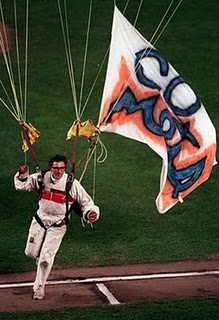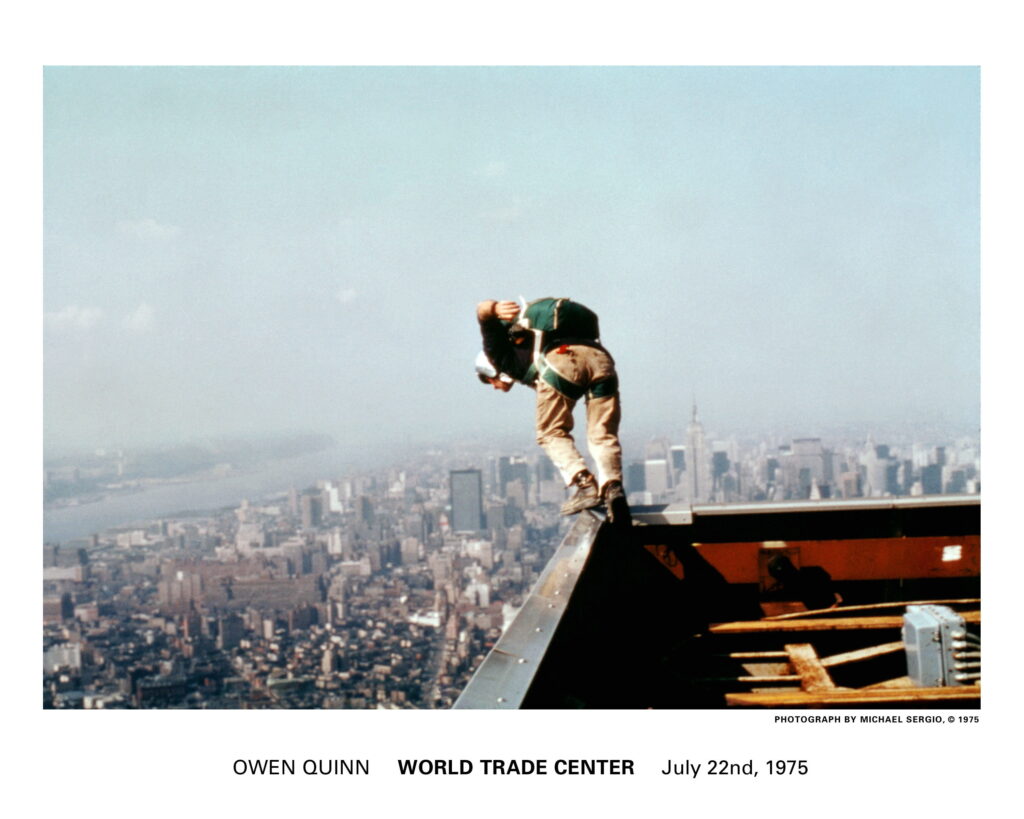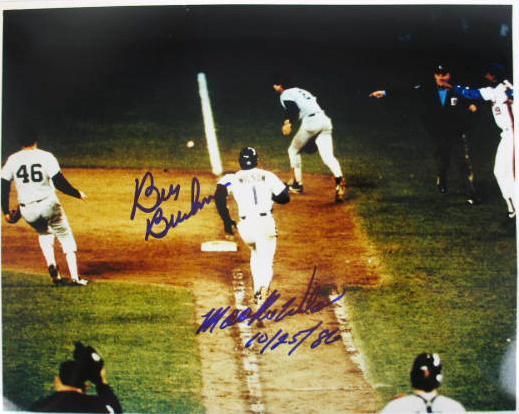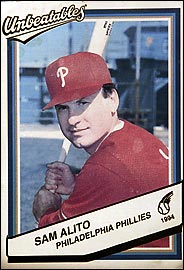 We go off topic today because it’s opening day, when hope springs eternal and your hometown team has yet to lose a game. And to celebrate, I bring you a baseball interview celebrating one of the most memorable World Series the sport has ever seen.
We go off topic today because it’s opening day, when hope springs eternal and your hometown team has yet to lose a game. And to celebrate, I bring you a baseball interview celebrating one of the most memorable World Series the sport has ever seen.
This is the 25th anniversary season of the 1986 Mets v. Red Sox series. And I was there in Shea Stadium for all four of the home games, having used some creative means of getting inside, since most of the tickets went corporate. (The statute of limitations has passed, thankfully, on my creative means, and Shea is no more.)
And it was Game 6 of that series that will live on in the minds of sports fans. Not only because the Red Sox were up by two in the 10th inning and just one measly out away from ridding themselves of the Curse of the Bambino..and the Mets rallied…and a legendary at bat by Mookie Wilson that included a game-tying wild pitch by Bob Stanley that skipped past Rich Gedman, and a game-ending error by Bill Buckner when Wilson’s squibbler went through his legs.
No, the game was memorable for something else as well. For Mike Sergio drifting down out of the Queens night sky with a Go Mets banner strung from his rigging that turned him into an instant cultural icon. And to celebrate the 25th anniverary of that season, I decided to interview Sergio, now an actor and filmmaker (and an Emmy winner) (whose jump was profiled at length in this 1989 Sports Illustrated article)
1. You landed on the field in the first inning of Game 6 of the ’86 series, and were promptly arrested. So does that mean you were in custody when Mookie Wilson had his legendary at bat in the bottom of the 10th and the Mets came from behind to beat the Red Sox? How did you feel about missing the game?
My brother David Sergio (sadly he passed away from cancer just after I was released from prison) was a NYPD police officer and in the vicinity of Shea Stadium at the time of my jump. Needless to say when he showed up at the local precinct the atmosphere turned pretty festive. I was really concerned that if the Mets lost the game the media, and worst of all the Met fans, would instantly blame me and then I’d have to move out of NYC… and believe me I really wasn’t looking forward to living on a farm in Canada… not that there’s anything wrong with Canada (ok, let’s just leave the Toronto Blue Jays out of this discussion). So, with the baseball gods smiling on me, a TV suddenly appeared and I was able to watch the end of the game. At the top of the 10th inning I was already mentally planning how much winter clothing I should pack for my trip north but then the beautiful, marvelous and amazing Mets went to work… and what a job they did. Where I was, and I can’t say too much about where I was, everybody went absolutely wild. So in my mind I quickly unpacked my winter clothes and went to work signing autographs. Like Rick in Casablanca, all I could think was “of all the games, in all the towns, in all the world, I picked this one to jump into”… yahooo!!!
2. Were you still in custody for Game 7? Did they let you watch the Mets win the Series?
The next morning Judge Alan Beldock released me on my own recognizance and ordered a court hearing. The Judge said to me “I’m a Mets season-ticketholder, I was there when it happened. I’m still trying to figure where you came from.” So yes I was out and free and able to watch game 7… and I was trilled to see fans in the bleachers holding up signs like “send in Sergio.”
3. Has there ever been a moment in your life when you regretted the jump?
Not a single time… not for a single moment… not even when I was in jail and I honestly thought I was going to have to do at least 18 months on the contempt of court charge… not even then. Obviously it was a more innocent time, but in my heart I knew that what I did, I did for fun and to show support for our New York Mets. So whatever was to come I was just going to take it and then move on. I never thought it would be any big deal and I was really amazed at how much of an event it became.
4. In the 25 years since that stunt, did you pull off any others? Or did you simply quit while you were ahead?
STUNT!!!!! Eric please, as a sensitive artist I prefer to call what I did “my performance art”… and yeah, I quit while I was ahead. I couldn’t see myself, in my waining years, jumping into country fairs for 50 bucks and a ride on the Giant Ferris Wheel. But actually that doesn’t really seem all that bad right now… hummm?
5. Did you lose any acting/film jobs as a result of the stunt? Or gain any?
Actually I never used the event to try and capitalize off of… and I was always very conscientious about keeping my jumping separate from my artistic life (although I did do one skydiving Wendy’s commercial which I think I booked before the Shea jump anyway?). The networks put out feelers about doing a film but I turned everything down. At the time I was acting on a soap (Loving), I was in numerous commercials, I was singing almost every night at the NY Improv, I had recently been in a Broadway play for 2 years (I Love My Wife), I had sold a screenplay that actually got made (Simple Justice) and I was starting a directing career that has turned into something wonderful for me (I’ve won an Emmy for Directing and numerous awards for my film & theatrical distribution company CAVU Pictures). But now, 25 years later, some very creative people have approached me about doing both a book and a film about the event, but like everything in the film business, it would be dependent upon them raising the funds to do it. But honestly, at this point in my life I think it would be great fun… so, we’ll see what happens.
6. Do strangers ever recognize you (or your name)? And if so, is it for your Shea jump or your film work?
Wow… this just happened… I was in Trader Joe’s on 6th Avenue about 2 weeks ago and I’m pushing a shopping cart down the vegan isle when a young guy who’s pushing his cart in the opposite direction looks up and with a questioning surprise on his face points at me and says… “Mike Sergio”? So I figured he’s a crew guy who I must have hired on one project or another and I say “yeah, that’s me”. He goes absolutely nuts… I mean he is really happy to see me and he says “Mike Sergio from the 1986 World Series”? Now I’m stunned because this guy doesn’t look like he was even born when I did the jump… and he holds up a magazine section that one of the dailies had just done about the Mets so now I’m floored. Over the years my hair has sprouted an age appropriate amount of gray and I have definitely become gravity enhanced… so I say to the guy “how did you recognize me” and he says back “because your face looks exactly the same”. OK, so I took that compliment and just jumped into the moment. I signed his Trader Joe’s produce flyer, or it might have been a notebook that he had… who can remember with all the excitement. But then reality starts to set in and I said to him “come on… are you from the government”… but he doesn’t skip a beat and he says that his girlfriend is in college and she’s has this big Mets sports blog and he instantly called her… so yeah… I still get recognized.
7. When you failed to cough up the name of the pilot — who violated a few aviation rules when he dropped you from the sky so close to LaGuardia Airport — you were held in contempt of court and jailed for three weeks. The judge finally let you go when he realized you weren’t going to talk. Is there any chance that the pilot, assuming he is still alive, will release you from your vow of silence? And if so, is that day today?
Like I said… (cue the heavy New York accent)… “I’m just glad I had my parachute on when I fell out of the bleachers” (cut… one more time with feeling please).

8. In 2006
Jeb Corliss tried to BASE jump off the Empire State Building, apparently with the objective of landing in the street. He was arrested on the observation deck, and then sued for emotional distress. He was convicted of reckless endangerment and lost his civil suit. I thought it was a spectacularly stupid stunt due to the risk of stunned drivers in midtown Manhattan and pedestrians being distracted. As a stunt junkie yourself — and someone who assisted
Owen Quinn in being first person to BASE jump off the World Trade Center — how did you feel about it?
STUNT JUNKIE!!!!! Eric please… for the last time… I prefer to call myself a “performance art junkie”!!! Now this is a bit of a dicey question for me, and being of the legal persuasion I know you’ll appreciate my situation so… I’m lawyering up and taking the 5th.
9. What’s the most common question you get asked about the stunt?
STUNT!!!… AGAIN WITH THE STUNT!!!! That’s it… no answer for you… next!!!
10. Have the Mets invited you down to participate in this year’s 25th celebration?
Actually while the players were always really supportive of me the Mets organization itself has not been. I can understand their position but you would think a PR person would see the value of giving a “walk on” to the guy who parachuted into the 1986 World Series…. you know to fire up the crowds! In fact a couple of years ago they invited a parachutist to jump into the stadium and people wrote that it was me jumping in again. Wow… now I’m a franchise and get credit for jumps I don’t even do. (Hey can I get them on ‘Performance Art Infringement’?) Last year I even went down to the Mets open call for singers (and I can sing!!!) to try out for one of 5 slots to sing the National Anthem at Shea… but I literally got a “Mr. Sergio, don’t call us, we’ll call you” message.
Oh well… life goes on.
11. The Mets are going to win it all this year, right?
All the way baby… all the way!!!
12. If you were conducting this interview, what question do you think should be asked? And how would you it?
Question #1: Mr. Sergio are you available for dinner and perhaps some light cocktails.
Answer #1: Why Scarlett Johansson… of course I am darling… of course I am… your place or mine?





